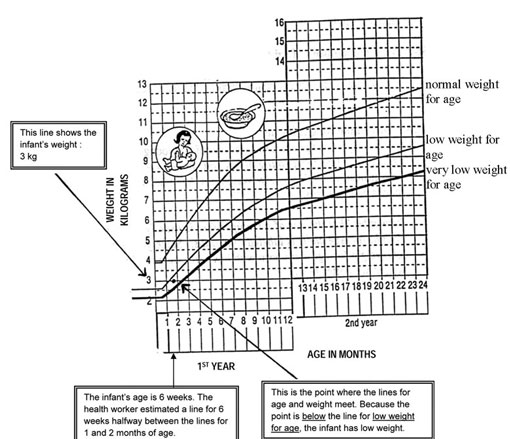Assessing feeding problems
Assessing feeding problems in infants and children is a two-stage process. First, there are some important questions that you need to ask the mother. Remember that she may be feeling anxious about her baby's feeding, so you should try asking questions in different ways if you feel that you are not getting the information you need to be able to complete your assessment. You should ask the mother if she is having difficulty feeding the infant, what the young infant is fed and how often. Secondly, you need to assess if the infant has any problems with breastfeeding or if the infant is low weight for their age (underweight).
Table 10.1 below sets out the questions you should ask the mother.
Table 10.1 Assessing feeding problems in infants.
| Ask | Look, listen, feel: |
|---|---|
|
|
ASK: Is there any difficulty feeding?
Any difficulty mentioned by the mother is important. She may need counselling or specific help with a difficulty and as a Health Extension Practitioner you have an important role to play in helping the mother overcome any problems she is experiencing. For example, the mother may mention difficulties in breastfeeding. These may include that her infant feeds too frequently, or not frequently enough; that she does not have enough milk; that her nipples are sore; that she has flat or inverted nipples; or that the infant does not want to take the breast.
An infant who can't feed may have a life-threatening problem. Refer urgently to hospital.
If a mother says that the infant is not able to feed, you should assess breastfeeding or watch her try to feed the infant with a cup to see what she means by this. An infant who is not able to feed may have a serious infection or other life-threatening problem and should be referred urgently to hospital.
ASK: Is the infant breastfed? If yes, how many times in 24 hours?
Young infants should be breastfed as often and for as long as the infant wants, day and night. This should be eight or more times in 24 hours.
ASK: Does the infant receive any other foods or drinks? If yes, how often?
A young infant should be exclusively breastfed. Find out if the young infant is receiving any other foods or drinks such as other milk, juice, tea, thin porridge, dilute cereal, or even water. Ask the mother how often the infant receives it and the amount that the infant is eating. You need to know if the infant is mostly breastfed, or mostly fed on other foods.
ASK: What do you use to feed the infant?
If an infant takes other foods or drinks, find out if the mother uses a feeding bottle, cup or something similar to give her infant food and drink.
LOOK: Determine weight for age
Use a weight for age chart to determine if the young infant is low weight for age. Notice that for a young infant you should use the low weight for age (underweight) line, instead of the very low weight for age (severely underweight) line, which is used for older infants and children. You decide low weight for age in young infants and very low weight for age in older infants and children in the following ways.
To determine weight for age:
- For young infants calculate their age in weeks; for older infants and children you should calculate their age in months.
- Weigh the infant/child if they have not already been weighed today. Use a scale that you know gives accurate measurements. The infant/child should wear light clothing when they are weighed. You should ask the mother to help remove any coat, sweater, or shoes.
- Use the weight for age chart to determine the child's weight for age (see Figure 10.1).
- Look at the left-hand axis to locate the line that shows the infant's/child's weight.
- Look at the bottom axis of the chart to locate the line that shows the infant's/child's age in weeks or months.
- Find the point on the chart where the line for the infant's/child's weight meets the line for the infant's/child's age.
- Decide where the point is situated.
In young infants, if the point is situated below the low weight for age line then the infant has low weight. If the point is above or on the low weight curve then the young infant is not low weight for age.
Example: A young infant is six weeks old and weighs 3 kg. Figure 10.1 shows you how the Health Extension Practitioner checked if the infant was low weight for age.
In older infants and children, if the point is below the line for very low weight (below the bottom curve) then the child has very low weight for age. If the point is above or on the bottom curve, the child is not very low weight for age.
Example: Look at Figure 10.2. This is a chart for a child who is 27 months old and weighs 8.0 kilograms. Look at how the Health Extension Practitioner determined the child's weight for age.


What is the best way to get information from the mother about her child's feeding?
Show answer
You should ask the mother questions to find out whether the child is feeding easily and, if under six months, whether breastfed exclusively. The mother may be feeling anxious about her child, so you should ask questions in a way she understands. This might mean you have to ask for the information you need in different ways. You should ensure she feels you are being supportive, rather than critical.